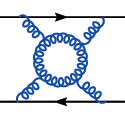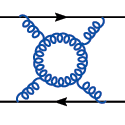Loopy precision
Quantum chromodynamics (QCD), the relativistic quantum theory that describes the interactions of quarks and gluons to make up hadrons, is a pillar of the standard model of particle physics. Yet it remains a work in progress. This is because, while QCD has obvious similarities to the much simpler quantum theory of electrodynamics that involves electrons interacting through exchanges of photons, gluons carry a color quantum number leading to a marked increase in complexity in the number of fundamental interactions.
The static potential between two heavy quarks is a fundamental quantity in QCD that enters the description of several measurable quantities such as threshold production of quark pairs and quark bound states. Though it is possible to compute this potential using perturbation theory, the complicated interactions amongst quarks and gluons pose a challenge. It took more than twenty years to reliably compute the second-order corrections to the potential after the first-order corrections were first computed in the late 1970s!
Writing in Physical Review Letters, two research groups have independently computed the third-order (three-loop) corrections to the interquark potential. This benchmark calculation was carried out by Alexander Smirnov and Vladimir Smirnov from Moscow State University, Russia, and Matthias Steinhauser from Karlsruhe Institute of Technology, Germany, and independently by Chihaya Anzai and Yukinari Sumino from Tohoku University and Yuichiro Kiyo from KEK, both in Japan. The two calculations agree with each other and provide state of the art results for a building block in many physical quantities, some of which are likely to be measured at a future electron-positron linear collider and the large hadron collider at CERN. The potential is also crucial for comparing perturbation theory with lattice simulations. – Abhishek Agarwal





